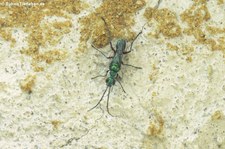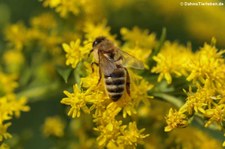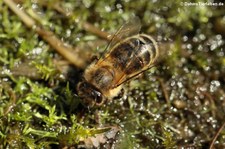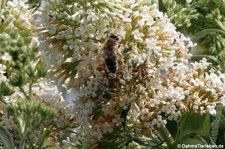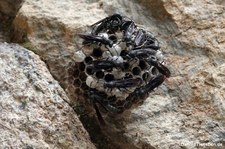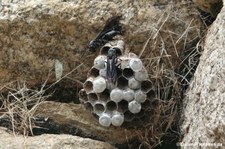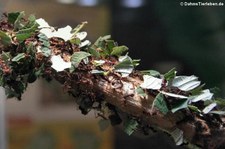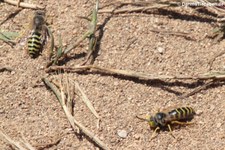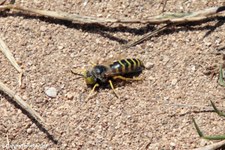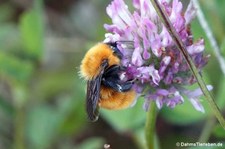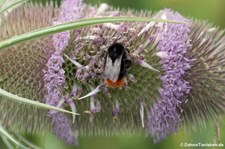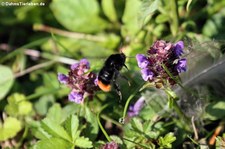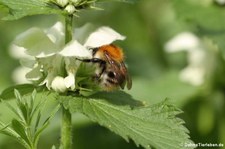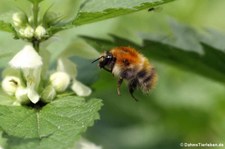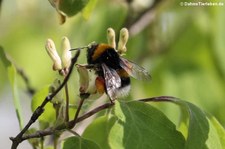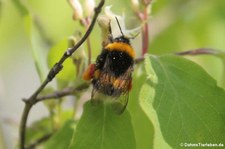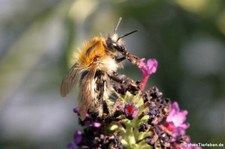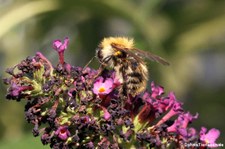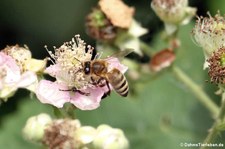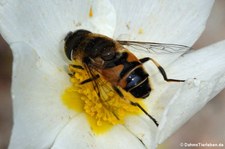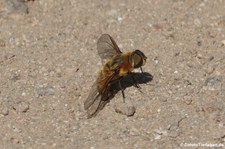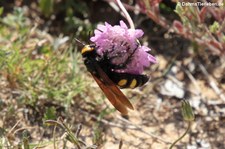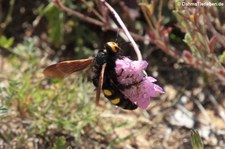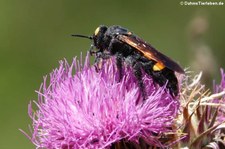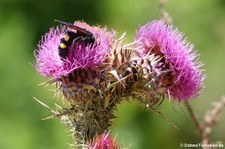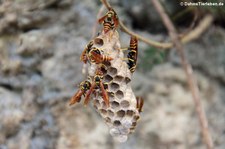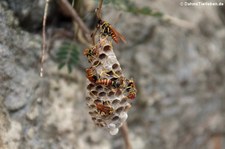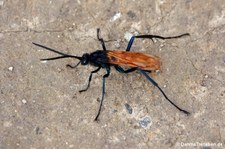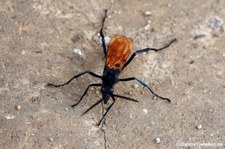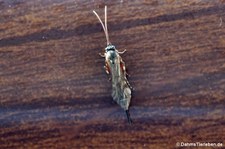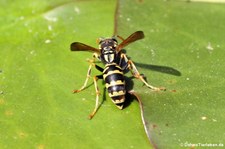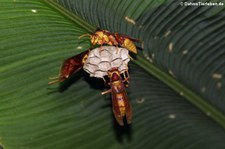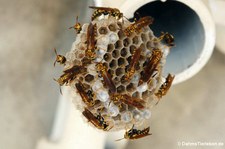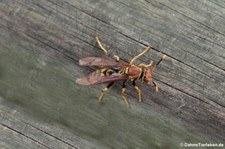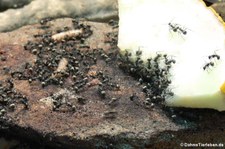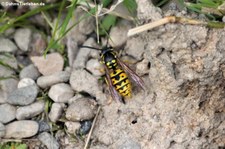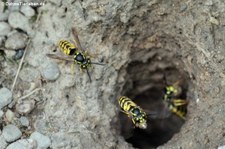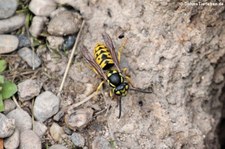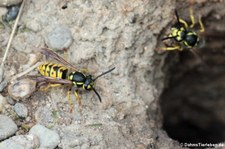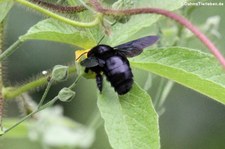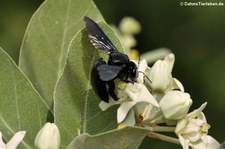Galerie der Hautflügler (Hymenoptera)
Die Hautflügler werden gerne umschrieben als "eine ökologische Schlüsselgruppe mit entscheidender Bedeutung für Struktur und Funktion fast aller terrestrischen Ökosysteme" (Zitat aus Wikipedia). Als Beispiel wird die Bedeutung der Bienen für die Bestäubung der Pflanzen angeführt. Hautflügler sind meist kleine bis mittelgroße Insekten, die maximal etwa 6,5 cm Körperlänge und 10 cm Flügelspannweite erreichen. In ihrer Entwicklung durchlaufen sie eine vollständige Metamorphose, von der Larve beginnend über eine Puppe bis zum ausgewachsenen Insekt (Imago). Der Kopf des ausgewachsenen Insekts ist zumeist sehr beweglich und über eine dünne Halsregion mit dem Rumpf verbunden. Die meisten Arten besitzen zwei Flügelpaare, die im Flug aneinander gekoppelt sind und sich einheitlich bewegen.
Ampulex compressa
[FABRICIUS, 1781]
- Deutsch: Juwelwespe
- Français:
- English: Emerald cockroach wasp or Jewel wasp
- Español: Avispa esmeralda
- Nederlands:
Apis mellifera
[LINNAEUS, 1758]
- Deutsch: Westliche Honigbiene oder Europäische Honigbiene
- Français: L'abeille européenne
- English: Western Honey Bee
- Español: Abeja europea
- Nederlands: Honingbij
Aporus spec.
- Deutsch:
- Français:
- English:
- Español:
- Nederlands:
Atta spec.
- Deutsch: Blattscheideameise
- Français:
- English: Leaf-cutting ant
- Español:
- Nederlands:
Bembix rostrata
[LINNAEUS, 1758]
- Deutsch: Kreiselwespe
- Français: Bembex à rostre
- English:
- Español:
- Nederlands: Harkwesp
 Bombus dahlbomii
Bombus dahlbomii
[GUÉRIN-MÉNEVILLE, 1835]
- Deutsch:
- Français:
- English: Patagonian bumblebe
- Español: Abejorro chileno
- Nederlands:
 Bombus lapidarius
Bombus lapidarius
[LINNAEUS, 1758]
- Deutsch: Steinhummel
- Français: Bourdon des pierres
- English: Red-tailed bumblebee
- Español:
- Nederlands: Steenhommel
 Bombus pascuorum
Bombus pascuorum
[SCOPOLI, 1763]
- Deutsch: Ackerhummel
- Français: Bourdon des champs
- English: Common Carder Bee
- Español:
- Nederlands: Akkerhommel
 Bombus terrestris
Bombus terrestris
[LINNAEUS, 1758]
- Deutsch: Dunkle Erdhummel
- Français: Bourdon terrestre
- English: Buff-tailed bumblebee
- Español: Abejorro común
- Nederlands: Gewone aardhommel
 Colletes cunicularius
Colletes cunicularius
[LINNAEUS, 1761]
- Deutsch: Frühlings-Seidenbiene
- Français:
- English: Mining bee
- Español:
- Nederlands: Grote zijdebij
 Colletes daviesanus
Colletes daviesanus
[SMITH, 1846]
- Deutsch: Gemeine Seidenbiene
- Français:
- English:
- Español:
- Nederlands: Wormkruidbij
 Eristalis tenax
Eristalis tenax
[LINNAEUS, 1758]
- Deutsch: Mistbiene
- Français: Éristale gluante
- English: Common drone fly
- Español:
- Nederlands: Blinde bij
Megascolia maculata flavifrons
[DRURY, 1773]
Diese Unterart kommt vor im westlichen Mittelmeerraum (Italien, Frankreich, Spanien, Andorra, Korsika, Balearen, Marokko und Algerien).
- Deutsch: Gelbköpfige Dolchwespe
- Français: Scolie à front jaune
- English: Mammoth Wasp
- Español: avispa puñal o avispa parásita de 4 puntos
- Nederlands:
Mischocyttarus mexicanus cubicola
[RICHARDS, 1978]
- Deutsch:
- Français:
- English:
- Español:
- Nederlands:
Pepsis grossa
[FABRICIUS, 1798]
- Deutsch: Tarantulafalke
- Français:
- English:
- Español:
- Nederlands:
Pimpla rufipes
[MILLER, 1759]
- Deutsch: Schwarze Schlupfwespe
- Français:
- English: Black slip wasp
- Español:
- Nederlands:
Polistes dominula
[CHRIST, 1791]
- Deutsch: Gallische Feldwespe oder Haus-Feldwespe
- Français: Poliste gaulois
- English: European paper wasp
- Español: Avispa cartonera
- Nederlands: Franse veldwesp
Polistes major
[PALISOT DE BEAUVOIS, 1818]
- Deutsch: Papierwespe
- Français:
- English: Horse's wasp
- Español: Avispa de caballo
- Nederlands:
Polistes myersi curassavicus
[RICHARDS, 1978]
- Deutsch: Curaçao Papierwespe
- Français:
- English: Curaçao Paper Wasp
- Español:
- Nederlands:
Polistes versicolor
[OLIVIER, 1791]
- Deutsch:
- Français:
- English: Yellow Paper Wasp
- Español:
- Nederlands:
Polyrhachis dives
[SMITH, 1857]
- Deutsch: Schwarze Weberameise
- Français:
- English:
- Español:
- Nederlands:
Vespula germanica
[FABRICIUS, 1793]
- Deutsch: Deutsche Wespe
- Français: Guêpe germanique
- English: German wasp
- Español: Chaqueta amarilla
- Nederlands: Duitse wesp
Xylocopa darwini
[COCKERELL, 1926]
- Deutsch: Galápagos-Holzbiene
- Français:
- English: Galápagos carpenter bee
- Español:
- Nederlands:
Xylocopa
Bei diesem Insekt ( aufgenommen im Kui Buri Nationalpark, Thailand) handelt es sich um eine Holzbiene der Gattung Xylocopa. Möglicherweise Xylocopa latipes oder Xylocopa tenuiscapa
- Deutsch:
- Français:
- English:
- Español:
- Nederlands:
Die Gefährdungsstufen gemäß IUCN
EX - Extinct (ausgestorben) / EW - Extinct in the Wild (in der Natur ausgestorben) /
CR - Critically Endangered (vom Aussterben bedroht) / EN - Endangered (stark gefährdet) /
VU - Vulnerable (gefährdet) / NT - Near Threatened (potenziell gefährdet) / LC - Least Concern (nicht gefährdet)
Bitte helfen Sie uns, die Korrektheit der Bilder sicherzustellen. Haben Sie einen Fehler erkannt? Haben wir ein Bild einer falschen Art zugeordnet? Ist der Artname veraltet? Wir sind dankbar für jeden Hinweis.
Weitere Galerien

